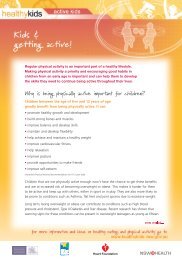I Move We Move - Good For Kids - NSW Government
I Move We Move - Good For Kids - NSW Government
I Move We Move - Good For Kids - NSW Government
Create successful ePaper yourself
Turn your PDF publications into a flip-book with our unique Google optimized e-Paper software.
5.5<br />
3. Preschoolers (three to five years old)<br />
Appropriate fundamental movement skills for preschoolers to explore are:<br />
• Stability – balancing, bending, stretching, twisting<br />
• Locomotor – crawling, walking, running, jumping, leaping, hopping, side-sliding, galloping<br />
• Manipulative – catching, throwing, kicking, striking a stationary ball, stationary dribbling<br />
This period involves building on early development of and experimentation with each of the<br />
locomotor, stability and manipulative skills that occurred in the toddler period. Having specific<br />
opportunities to practice these skills and to receive feedback and encouragement from parents and<br />
other significant adults is crucial during the preschooler period. This is what supports improvement<br />
in these skills, as it does not occur as part of normal growth and development 16 .<br />
The importance of planned, adult guided activities<br />
As children do not naturally learn to correctly perform fundamental movement skills as part of their<br />
normal growth and development, it is important that children experience guided opportunities to<br />
practice and develop each skill. Children's Services can best facilitate the development of fundamental<br />
movement skills in children by providing frequent learning experiences as well as encouraging their<br />
efforts through giving verbal prompts. Ideas to support these practices are provided in the<br />
following pages.<br />
Adult guided developmental movement activities for babies<br />
Adult guided developmental movement activities will mostly involve one on one interaction (e.g.<br />
as a focus child experience or during care giving) or setting up the room to encourage movement.<br />
Frequency and Duration<br />
Programming adult guided developmental movement activities into each day will enable all babies<br />
attending the service to experience these activities at least once a week. Baby will let you know if<br />
they are ready to participate in the activity, both at that time and also developmentally.<br />
Verbal prompts<br />
Talking or singing to babies about what is happening, what body parts are being touched and<br />
moved during these activities assists with increasing their awareness of the existence, dimensions<br />
and abilities of their body overall and the individual parts 15 .<br />
See The Physical Activity Handbook – Babies (pages B.8-B.12) for<br />
examples of adult guided developmental movement activities.<br />
I <strong>Move</strong> <strong>We</strong> <strong>Move</strong>, The Guide Edition 1 August 2009<br />
AREA HEALTH SERVICE




